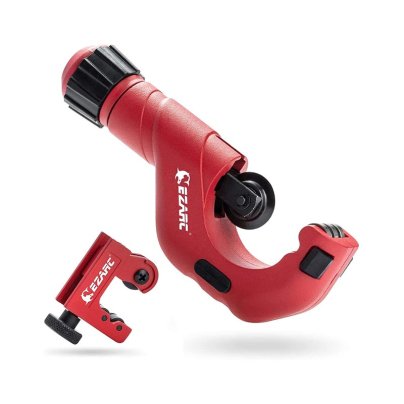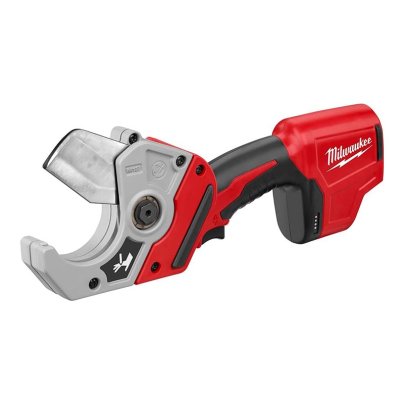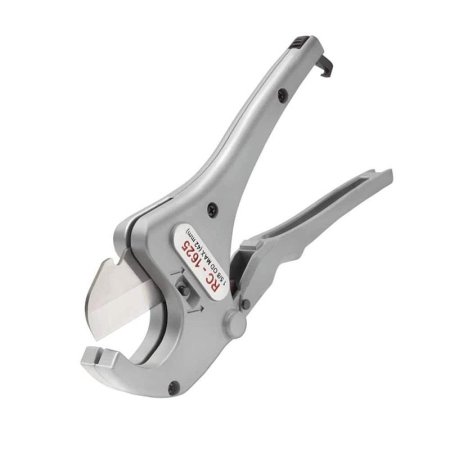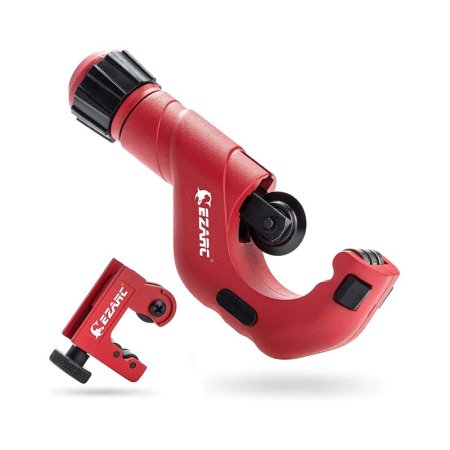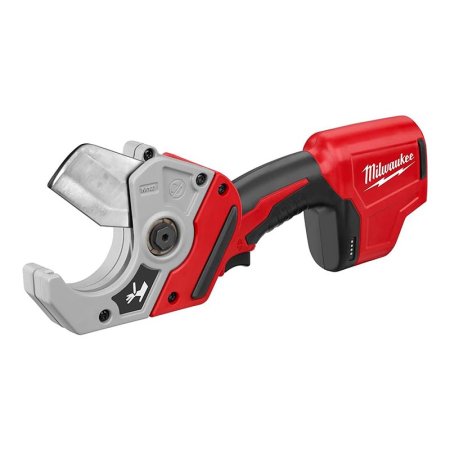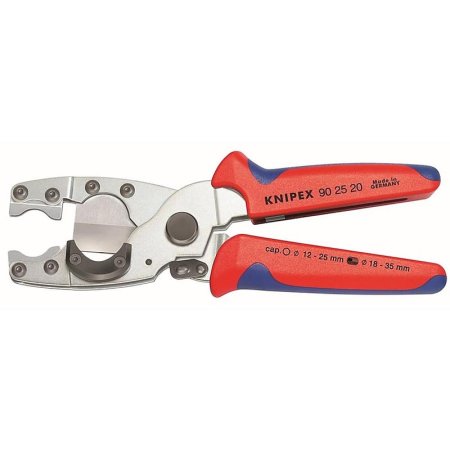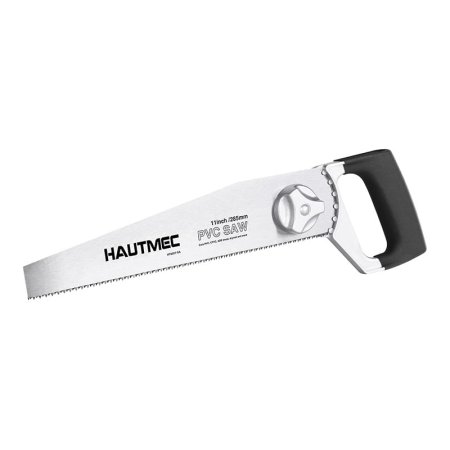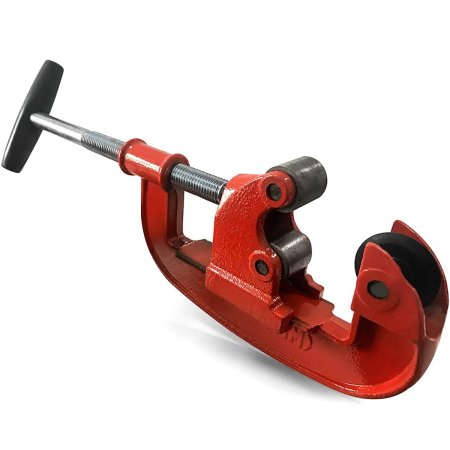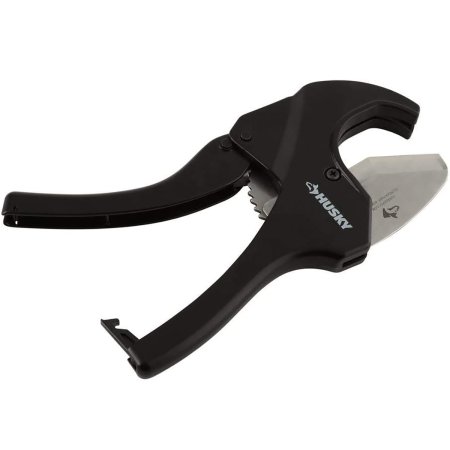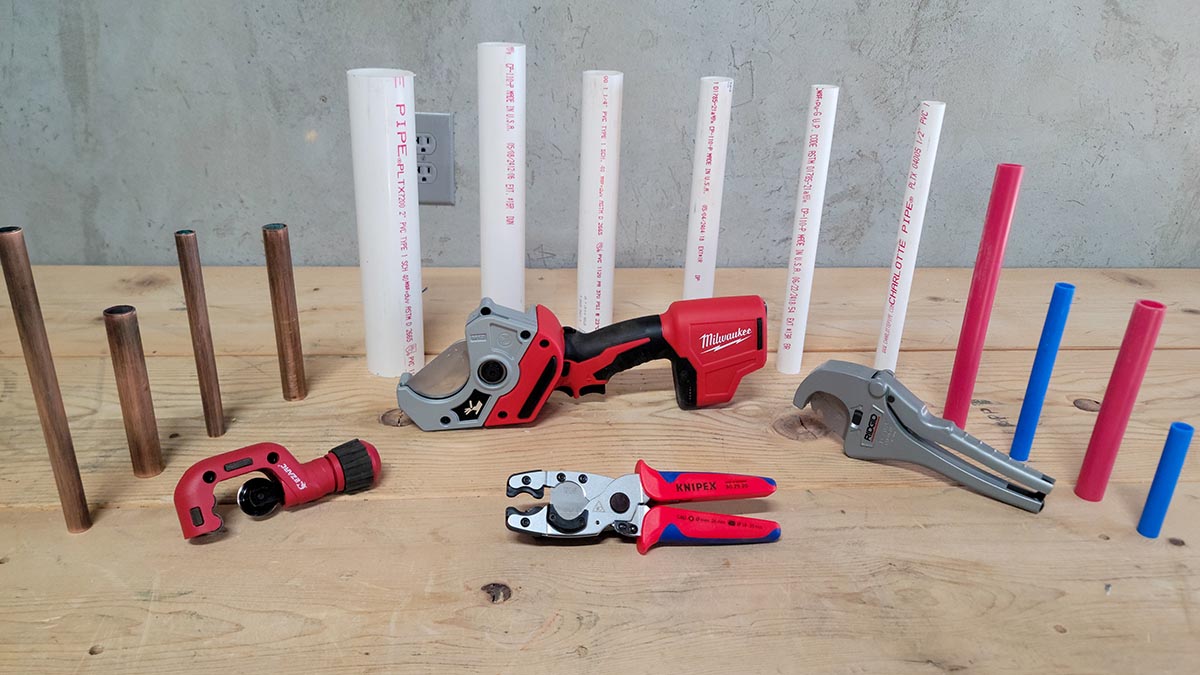
We may earn revenue from the products available on this page and participate in affiliate programs. Learn More ›
Installing polyvinyl chloride (PVC) pipe for plumbing, HVAC, or other projects requires making clean slices, and PVC pipe cutters serve just that purpose. These cutters are available in various types, from manual versions to fully electric cutters that do all the work with the push of a button.
We researched more than 24 top-rated PVC pipe cutters, selected seven as our top picks, and tested four in our workshops. Our testing turned up a favorite—the Ridgid RC-1625 Plastic Pipe and Tubing Ratchet Cutter. While all the cutters we tested performed well, the Ridgid pipe cutter features a ratcheting action that greatly reduces the amount of elbow grease required to cut the pipes.
Keep reading to learn about some of the most important factors to consider when shopping for this specialized tool and to discover how the following models earned their place in this guide of the best PVC pipe cutters for DIYers and pros.
- BEST OVERALL: Ridgid RC-1625 Plastic Pipe and Tubing Ratchet Cutter
↓ Jump to Review - BEST BANG FOR THE BUCK: Ezarc Heavy-Duty Pipe Cutter
↓ Jump to Review - BEST ELECTRIC: Milwaukee M12 Plastic Pipe Shear
↓ Jump to Review - BEST FOR PROS: Knipex 8½-Inch PVC Pipe Cutter
↓ Jump to Review - BEST HANDSAW: Hautmec 11-Inch PVC/ABS Pipe Saw
↓ Jump to Review - BEST FOR LARGE PIPES: Qwork Professional Pipe Cutter
↓ Jump to Review - BEST HEAVY-DUTY: Husky 2-Inch Ratcheting PVC Cutter
↓ Jump to Review
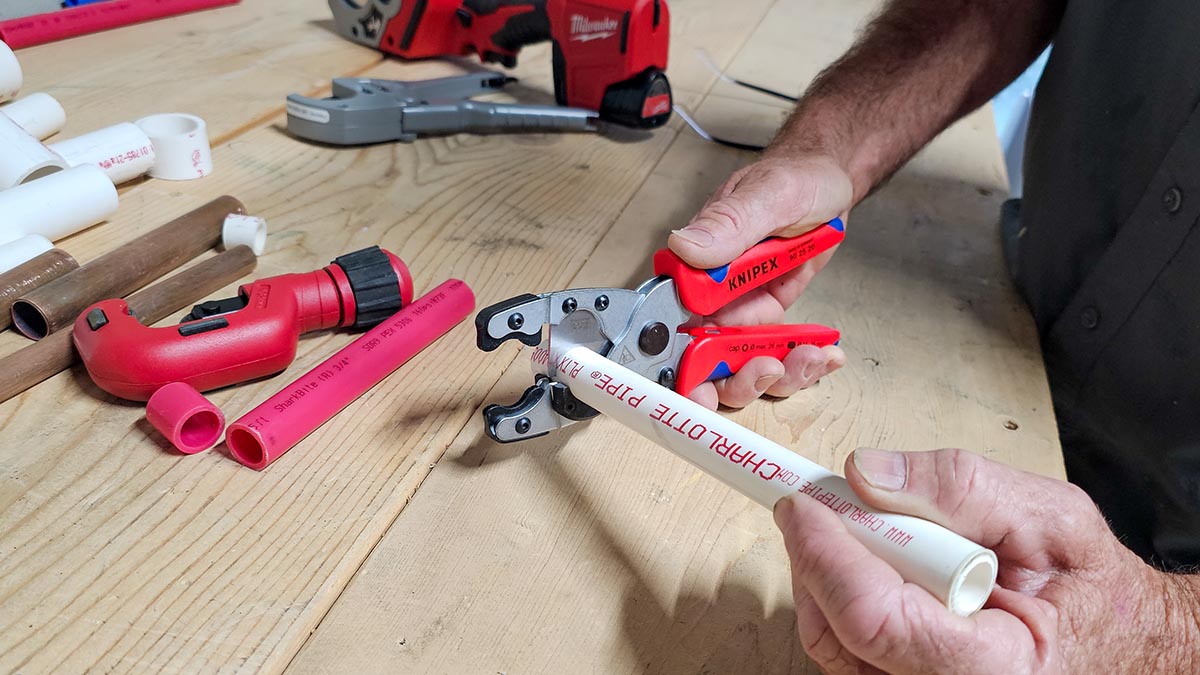
Our Top Picks
We hand tested the first four picks in this guide to see how well they performed on different PVC pipe sizes—and whether they would leave clean cuts without burrs requiring extra filing. Read on to find out more about some of the best PVC pipe cutters on the market today.
Best Overall
Ridgid RC-1625 Plastic Pipe and Tubing Ratchet Cutter
Product Specs
- Type: Ratcheting
- Cutting capacity: ⅛ inch to 1⅝ inches
- Blade material: Not provided
Our Ratings: Ergonomics 4.5/5; Cut Quality 4.8/5; Performance 5/5; Value 4.3/5;
What We Like
- Grips double as a pipe-measuring scale
- Ratcheting mechanism reduces user fatigue
- Cuts PVC, CPVC, PP, PEX, PE, and more
- Includes X-CEL quick-change blade system
What We Don’t Like
- Limited cutting capacity
- Grips are not nonslip
- Blade material is not noted by the manufacturer
Cutting through PVC pipe doesn’t need to be difficult. We were pleasantly surprised at the clean cuts we could make with the Ridgid RC-1625 pipe cutter. Its ratcheting action allowed us to cut through pipes up to 1⅝ inches through several squeezes of the handles without having to open the jaws and recut.
Any decent PVC cutter can make clean cuts on pipes less than about ¾ inch in diameter, but when the pipes are 1 inch or more, a solid cutter with ratcheting action is the best option. We could make straight cuts in pipes ½ inch or less with just one squeeze of the handles. It took three squeezes to cut through a 1½-inch pipe.
The Ridgid pipe cutter weighs 1 pound, so it feels substantial in hand, yet it isn’t so heavy as to cause hand fatigue. We made dozens of cuts in PVC and also tried cutting PEX and plastic pipe. This model excelled with all three materials.
It doesn’t include a replacement blade, but they are available at Ridgid, Amazon, and other retailers. However, the manufacturer doesn’t indicate the material with which the blade is constructed. If we could choose one improvement to the Ridgid PVC cutter, it would be to add nonslip material to the grips. When working in a warm environment, the grips can feel slightly slippery. Overall, this stellar PVC cutter would be welcome in any DIYer’s or plumber’s tool box.
Get the Ridgid PVC pipe cutter at The Home Depot, Amazon, or Toolup.com.
Best Bang for the Buck
Ezarc Heavy-Duty Pipe Cutter
Product Specs
- Type: Manual
- Cutting capacity: 3/16-inch to 2-inch outer diameter
- Blade material: Heat-treated alloy steel
Our Ratings: Ergonomics 3.5/5; Cut Quality 4.5/5; Performance 4/5; Value 5/5;
What We Like
- Includes a second smaller pipe cutter
- Cuts PVC, stainless steel, aluminum, and copper
- Heat-treated blade
- Textured knob for better grip
What We Don’t Like
- Can cause hand and muscle fatigue
If you don’t mind spinning a cutter around a pipe, you can make clean cuts in PVC pipes without spending a lot of money. We found the Ezarc pipe cutter easy to use—all we had to do was insert a pipe into the jaws and then turn the knob at the end of the handle to tighten the cutting wheel against the pipe. Then, we turned the cutter around the pipe as many times as needed to cut through the pipe. On average, it took 5 to 12 turns to cut through a pipe depending on the thickness of the PVC. We retightened the knob as we worked to increase the cutting pressure on the pipe. This model offers a pipe-cutting capacity ranging from 3/16 inch to 2 inches in diameter (outside diameter).
The Ezarc cutter is also designed to cut stainless steel, aluminum, and copper pipe, and we tested it on ½-inch copper pipe with good results. It made straight, clean cuts.
A smaller cutter is included in the set, and it’s designed for use in tight spots where you can’t fit a larger tool. While we were able to make straight cuts with this smaller tool, it’s not as easy to adjust the blade tension as it is with the larger cutter. We had to manipulate a small knob with our fingers, and it was more challenging to turn this cutter around the pipes without a large handle for leverage. Still, the large and the small cutters both made straight cuts. If you’re looking for a PVC cutter for occasional use, this is a reliable set at an affordable price.
Get the Ezarc PVC pipe cutter at Amazon, Walmart, or Ezarc.
Best Electric
Milwaukee M12 Plastic Pipe Shear
Product Specs
- Type: Electric
- Cutting capacity: Up to 2-inch schedule 80 PVC (2⅜ inches in diameter)
- Blade material: Stainless steel
Our Ratings: Ergonomics 5/5; Cut Quality 4.8/5; Performance 5/5; Value 3.5/5;
What We Like
- Effortless operation to cut pipe in seconds
- Stainless steel blade
- Comfortable ergonomic grip
- Safety button prevents accidental cuts
What We Don’t Like
- Battery and charger are sold separately
If you have a lot of pipes to cut, check out the Milwaukee battery-powered pipe cutter. It uses battery power to make clean cuts in pipes up to 2⅜ inches in diameter without any physical effort from the user.
This was a fun and easy cutter to test. All we had to do was press a safety button on the side of the cutter to open the jaws, insert the pipe, and then squeeze the trigger to start the cutting action. After we did it a few times, the process was intuitive.
This cordless pipe cutter shears through PVC, CPVC, PEX, ABS, nonmetallic conduit, and rubber tubing, but it is not designed for use on copper or steel tubing. We tested it on ABS, PEX, and PVC, and it made straight, clean cuts on all three materials.
The Milwaukee tool is a pleasure to use; however, it comes at a premium price that doesn’t include the battery or a charger. It is worth the expense if you need to make hundreds of cuts, but if you only need to make a few cuts here and there, we’d recommend sticking with a hand-powered pipe cutter.
Get the Milwaukee PVC pipe cutter at Amazon, The Home Depot, or Acme Tools.
Best for Pros
Knipex 8½-Inch PVC Pipe Cutter
Product Specs
- Type: Manual
- Cutting capacity: ½-inch to 1-inch standard, ¾ to 1⅜-inch corrugated
- Blade material: Oil-hardened steel
Our Ratings: Ergonomics 4.8/5; Cut Quality 5/5; Performance 5/5; Value 4/5;
What We Like
- High-quality German construction
- Oil-hardened steel blades for precision
- Cuts PVC, composite, and corrugated pipes
- Professional-grade results
What We Don’t Like
- Not suitable for metal pipes
- Requires hand strength for frequent cuts
For plumbers or HVAC technicians who regularly install PVC or composite pipes, it’s hard to beat the Knipex 8½-inch pipe cutter. This high-quality German-made tool cuts PVC and other nonmetal pipes up to 1 inch in diameter. In addition, it features a second set of jaws that will cut flexible corrugated pipes up to 1⅜ inches in diameter.
We like the oil-hardened steel blades on this pipe cutter. They made clean, precise cuts on our pipes without leaving any burrs that required filing. The blades are replaceable, but we got the impression they’ll last a long time.
The Knipex cutter for pipe excelled at cutting PVC pipes, and we located some multilayer composite (MLC) pipes for testing as well. These pipes are typically used in plumbing and heating systems and require clean cuts for precise connections. We did have to use extra squeezing power on the thicker PVC, which might cause some hand fatigue if we had to cut that type of pipe consistently, but the quality of the cuts is outstanding on both materials.
This pipe cutter is more expensive than some of the other models we tested, but if making seamless, leak-free connections is crucial, it’s well worth the investment.
Get the Knipex PVC pipe cutter at Lowe’s, ToolNut, or KCTool.
More Great Options
While we didn’t test the following models, we selected them based on our extensive research. They meet and exceed our standards for quality and performance. If you’re still looking for a PVC pipe cutter after reading about the first four models, check out these options.
Best Handsaw
Hautmec 11-Inch PVC/ABS Pipe Saw
Product Specs
- Type: Handsaw
- Cutting capacity: Up to 8 inches
- Blade material: Carbon steel
What We Like
- Adjustable blade direction
- Double-cut, razor-tooth blades improve cutting efficiency
- Padded, ergonomic handle for enhanced user control
- Quick-release blade mechanism
What We Don’t Like
- Requires ample space for back-and-forth sawing motion
Pipe cutters with specially made jaws and cutting wheels are an excellent option for common pipe sizes, but we like this heavy-duty Hautmec pipe saw for cutting through unexpected pipe materials or large-diameter pipes. This handsaw can cut through PVC, CPVC, ABS, PPVC, CPVC, polypropylene-random (PP-R), PEX, PE, rubber tubing, PP, multilayer tubing, wood, and soft metals, such as nails.
The Hautmec pipe saw has a carbon-steel blade with double-cut razor teeth to quickly work with soft materials. It is for use on pipes up to 8 inches in diameter and features a quick-release mechanism intended to adjust the blade’s position by up to 70 degrees up or down. However, the saw’s length makes it a poor option for working in tight spaces.
When a standard pipe cutter is too small to cut the chosen pipe, we think this Hautmec saw is a great solution. But, as with any handsaw, take extra care to line it up and mark your pipe to ensure a straight cut.
Get the Hautmec PVC pipe saw at Amazon.
Best for Large Pipes
Qwork Professional Pipe Cutter
Product Specs
- Type: Manual
- Cutting capacity: 1 inch to 3 inches
- Blade material: Steel
What We Like
- Long shank protects adjustment threads
- Oversize adjustment handle improves grip and control
- Suitable for large-diameter pipes
- Heavy-duty steel construction
What We Don’t Like
- Can cause hand and muscle fatigue
Dealing with large-diameter PVC pipes can be difficult without the right tools because most pipe cutters are limited by the cutting capacity of their jaws. Handsaws are the exception to this problem because they lack jaws, allowing the serrated blades to cut through pipes of any size. However, the serrated blade can create burrs and crude edges, so we would choose an alternative pipe-cutting tool, such as this Qwork manual PVC pipe cutter, whenever possible.
This pipe cutter is similar to our Best Bang for the Buck pick earlier in this guide. Still, this model is made to cut even larger pipes (up to 3 inches in diameter), making it handy for commercial plumbers, irrigation specialists, or wastewater treatment technicians. It would also be a time-saver for a user who builds projects or furniture from 3-inch PVC pipe.
We like the heavy-duty steel construction and high-quality steel blades on this Qwork pipe cutter. It is designed with a long shank and an oversize adjustment handle, so it’s easier to grip and turn. This should help keep the blade tight against the pipe as you rotate the cutter around the material. Just keep in mind that hand and muscle fatigue is an ever-present risk with manual pipe cutters.
Get the Qwork PVC pipe cutter at Amazon.
Best Heavy-Duty
Husky 2-inch Ratcheting PVC Cutter
Product Specs
- Type: Ratcheting
- Cutting capacity: Up to 2 inches
- Blade material: Not provided
What We Like
- Cuts PVC, CPVC, PP, PEX, and PE pipe
- Durable, rust-resistant body
- Quick-release blade mechanism
- Ratcheting mechanism reduces hand fatigue
What We Don’t Like
- Blade material is not noted by the manufacturer
While this Husky PVC cutter isn’t one of the pricier tools, it is well made, designed to cut up to 2-inch pipes, and features a ratcheting action that makes repetitive cuts easier on the hands. In addition to PVC, this model is suitable for cutting CPVC, PP, PEX, and PE pipe, though it isn’t intended for use on metal, wire, or nails. It features a durable, rust-resistant body and is covered by Husky’s lifetime warranty, so users know that if the tool fails, they can return it for a replacement as long as they purchased it at The Home Depot.
This ratcheting pipe cutter has a quick-release blade mechanism that makes it easy to replace the blade. However, the manufacturer does not indicate the material with which the blade is made. It appears to be alloy steel, but we can’t say for sure. We’ve had good luck in the past with Husky hand tools, and we think this tool would be a great addition to any DIY plumber’s tool box.
Get the Husky PVC pipe cutter at The Home Depot or Amazon.
Jump to Our Top Picks
How We Chose and Tested the Best PVC Pipe Cutters
Due to the wide variety of pipe cutters, we needed to research a broad pool of options to find suitable PVC pipe cutters before we chose the top models for hands-on testing.
Our initial considerations were the type of PVC pipe cutter and the overall build quality and design of each product. We then considered cutting capacity: Although the vast majority of PVC pipe is 1 inch in diameter or less, we wanted to include tools that cut larger-diameter pipe. We also considered the amount of hand strength it took to cut different pipe sizes. Except for the battery-powered model, all other tested cutters required a measure of hand strength, so we noted the number of cuts we could make before our hands were fatigued.
In actual testing, we focused heavily on the quality of the cut. Cutting PVC pipe is generally necessary when making connections in plumbing or HVAC systems, so the cut must be straight, flush, and clean (no burrs to file off). Flush cuts are more likely to result in leak-free connections.
Then, we tried cutting the other kinds of pipes listed as suitable by the manufacturer when possible. While we didn’t have the full range of piping, such as pipes to carry potable water, we had most of the basic kinds.
Finally, we awarded points to each pipe cutter based on a rubric. The better a cutter performed, the more points it earned. After testing, we averaged the points to determine our Best Overall pick and categorize the other products according to their best use.
What to Consider When Choosing a PVC Pipe Cutter
Before selecting a new cutting tool for PVC pipe, it’s recommended that users learn more about each type of PVC cutting tool, the cutting capacity, and the blade material to choose the best PVC pipe cutting tool for their needs.
Type
Users can choose from several types of PVC pipe cutters, including ratcheting, manual, spring-loaded, electric, and handsaws.
Ratcheting
Ratcheting PVC and plastic pipe cutters are great for one-handed use because of the ratcheting system. When you squeeze the handles, the blade starts to close, ratcheting into a new position. The cutter remains in this position even when you release the handles, eliminating the need to worry about the blade releasing when adjusting the grip. One squeeze on the handles won’t slice through the pipe but gradually closes the blade around the pipe. With each subsequent squeeze, the blade begins to slice through the PVC pipe until it has cut cleanly through the material. We are big fans of ratcheting pipe cutters.
Manual
Manual PVC pipe cutters have a hook-shaped appearance with an opening with a cutting wheel to cut through PVC pipe. Users slide the pipe into the opening between the cutting wheel and the top of the hook shape, turn the adjustment knob on the handle to tighten the grip on the pipe, and then begin moving the cutter around the pipe. If the cutter feels too loose after a few turns, users can turn the adjustment knob to tighten the grip and resume cutting. After several rotations around the pipe and a few adjustments to ensure the blade is sinking deeper into the pipe with each revolution, the cutter will slice completely through the pipe.
Spring-Loaded
Spring-loaded PVC pipe cutters are simple to use, but they can cause significant strain on the user’s hands. This is because they are essentially oversize scissors with a single blade intended for cutting through tough, durable PVC pipe. Users must rely on their own strength and the sharpness of the blade to cut through the PVC. However, the spring-loaded jaws can help alleviate some of this strain.
Electric
An electric PVC pipe cutter tool is the easiest to use, but these models rely on a charged battery pack for power. If you haven’t charged the battery, the cutter is rendered useless. With a charged electric cutter, simply position the pipe in the cutting jaws and squeeze the trigger. The pipe cutter will take care of the rest, slicing through the PVC pipe quickly and effectively.
Handsaws
Handsaws are not exclusively used for cutting PVC pipe, but they can function well if one of the other types isn’t available or if the pipe is too big for the pipe cutter’s jaws. Plumbers often use a hacksaw, which is a type of handsaw, to cut through PVC, copper, lead, galvanized iron, and other materials. It’s recommended that users who frequently take up plumbing projects around the home invest in a handsaw.
Cutting Capacity
When looking for a new PVC pipe cutter, factor in the size of the pipe you plan to cut to ensure that the cutter’s jaws can fit around the pipe. Unfortunately, this can be confusing to determine because the stated diameter of a PVC pipe sometimes, but not always, refers to the inner diameter instead of the outer diameter.
For example, a piece of PVC pipe with a stated diameter of 1⅝ inches has an inner diameter with this measurement, so a PVC tube cutter with a maximum cutting capacity of 1⅝ inches would not be able to fit around the pipe. The actual measurement needed to compare the cutting capacity to the pipe is the outer diameter.
Luckily, most manufacturers will specify if the cutting capacity is for the inside or the outside of the pipe’s dimensions.
Blade Material and Replaceability
The blade is one of the most important parts of a pipe cutter because it is responsible for slicing through the PVC. Depending on the type of plastic pipe cutter, the blade can be a circular cutter wheel, a flat cutting edge, or a serrated cutting edge. Users will want to choose the type of cutter suitable for the project and research the blade material. Look for products with heat-treated steel blades that are resistant to rust and corrosion.
Another factor to consider is the replaceability of the blade. Most PVC cutting tools have replaceable blades, although the cost of the replacement blade might be higher than a new PVC cutter, so look into the price of replacement blades before investing in a PVC pipe cutter.
Ergonomics
Whether you’re operating a manual cutter, a spring-loaded cutter, or even an electric PVC pipe cutter, it’s essential to consider the grip, ease of use, and any additional features that can improve the tool’s ergonomics. Padded handles with soft grips can increase comfort, making it easier to cut through PVC pipe without creating hand strain and fatigue.
Consider looking for tools with helpful features, such as catch rings to hold the blade closed on a set of spring-loaded cutters or a textured adjustment knob on a set of manual plastic pipe cutters that makes it easier to grip and adjust the cutting-wheel position. However, ratcheting and electric pipe cutters are the best choices for ease of use and comfort because these tools are designed to do most of the work on their own.
FAQs
Even after deciding on a model, you may still have questions about what makes an ideal PVC pipe cutter. Consider these frequently asked questions and the detailed answers below to learn more about these tools.
Cutting PVC pipe isn’t difficult with the right tools. Some PVC pipe cutters, such as ratcheting or electric cutters, are easier to use. However, with a bit more effort, you can cut through PVC pipe with a manual cutter, a spring-loaded cutter, or even a handsaw. Overall, smaller pipes are generally easier to cut through than larger pipes due to the size and thickness of the material.
The price of a PVC pipe cutter depends on the brand of the cutter, the type of the cutter, and the size of the pipe it is designed to handle. On average, you can expect to pay from $15 for light-duty manual options to about $200 for an electric pipe cutter.
If you need to cut PVC pipe but aren’t able to purchase a suitable PVC pipe cutter, consider using a PEX pipe cutter to slice through PVC. You can also use a PVC pipe cutter on most PEX pipes, although if you’re installing PEX, you’ll need a crimping tool as well.
An internal pipe cutting tool is required to cut from the inside. These products are essentially cutting wheels that attach to a standard drill. Simply slide the cutting wheel inside the pipe and activate the drill to begin cutting through the PVC from the inside.
PVC pipe cutters are typically designed to only make straight cuts. If you need to make curved cuts, try a handsaw, an oscillating multi-tool, or a reciprocating saw.
First, make sure the blade is intended to be sharpened—some blade materials, such as carbide, are difficult to sharpen. Then, remove the blade and secure it in a vise. Use a fine file or sharpening stone to gently sharpen the edge and reinstall the blade.
The larger the pipe cutter, the more challenging it is to squeeze into tight spaces. Small, twist-type cutters work better in restricted areas.
Depending on the type of cutter and the blade material, a PVC pipe cutter may be able to cut other types of plastic pipes, copper pipes, rubber tubes, and composite tubes. However, keep in mind that PVC pipe cutters are not robust enough to serve as bolt cutters.
Meet the Tester
Glenda Taylor is a product tester and writer specializing in the construction, remodeling, and tool industries.
Additional research provided by Timothy Dale.

